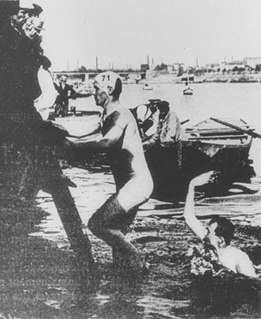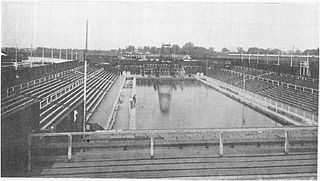
The men's 200 metre obstacle event was an obstacle swimming event in the 1900 Summer Olympics held in Paris. It was held on 11 August and 12 August 1900. Twelve swimmers from five nations competed. The event was won by Frederick Lane of Australia, with Otto Wahle of Austria second and Peter Kemp of Great Britain third. Lane had already won the 200 metre freestyle.
The men's 200 metre breaststroke was a swimming event held as part of the swimming at the 1912 Summer Olympics programme. It was the second appearance of the event, which had been introduced in 1908. Germany swept the medals in the event. The competition was held from Sunday July 7, 1912 to Friday July 12, 1912.
The men's 400 metre breaststroke was a swimming event held as part of the swimming at the 1912 Summer Olympics programme. It was the second appearance of the event, which had been introduced in 1904. The competition was held from Monday July 8, 1912 to Friday July 12, 1912.

The men's 100 metre freestyle was a swimming event held as part of the swimming at the 1920 Summer Olympics programme. It was the fourth appearance of the event. A total of 31 swimmers from 15 nations competed in the event, which was held from August 22 to August 29, 1920. Nations were limited to four swimmers each. The United States swept the medals, and Duke Kahanamoku broke his own Olympic record in the semifinals and bettered his time again in the final to successfully defend his championship from 1912. Kahanamoku was the first man to successfully defend an Olympic 100 metres freestyle title and third man to win multiple medals of any color in the event.
The men's 400 metre freestyle was a swimming event held as part of the swimming at the 1920 Summer Olympics programme. It was the third appearance of the event.
The men's 1500 metre freestyle was a swimming event held as part of the swimming at the 1920 Summer Olympics programme. It was the third appearance of the event.
The men's 100 metre backstroke was a swimming event held as part of the swimming at the 1920 Summer Olympics programme. It was the fourth appearance of the event.
The men's 200 metre breaststroke was a swimming event held as part of the swimming at the 1920 Summer Olympics programme. It was the third appearance of the event.
The women's 300 metre freestyle was a swimming event held as part of the swimming at the 1920 Summer Olympics programme. It was the first appearance of the event, which was later adjusted to 400 metres to match the men's competition.
The men's 100 metre freestyle was a swimming event held as part of the swimming at the 1924 Summer Olympics programme. It was the sixth appearance of the event, which had not been featured at the 1900 Games. The competition was held on Saturday July 19, 1924 and on Sunday July 20, 1924. There were 30 competitors from 15 nations. Nations were limited to three swimmers each, down from four in 1920. The United States swept the medals for the second consecutive Games, winning its fourth consecutive gold medal. Johnny Weissmuller beat two-time defending champion Duke Kahanamoku in the final. Kahanamoku was the first man to win three medals in the event. His brother Samuel Kahanamoku earned the bronze medal.
The men's 400 metre freestyle was a swimming event held as part of the swimming at the 1924 Summer Olympics programme. It was the fourth appearance of the event, which was established in 1908. The competition was held from Wednesday July 16, 1924 to Friday July 18, 1924.
The men's 200 metre breaststroke was a swimming event held as part of the swimming at the 1924 Summer Olympics programme. It was the fourth appearance of the event, which was established in 1908. The competition was held on Tuesday July 15, 1924, on Wednesday July 16, 1924, and on Thursday July 17, 1924.

The men's 100 metre freestyle was a swimming event held as part of the swimming at the 1928 Summer Olympics programme. It was the seventh appearance of the event, which had not been featured only at the 1900 Games. The competition was held on Friday and Saturday, 10 and 11 August 1928. Thirty swimmers from 17 nations competed. Nations had been limited to three swimmers each since the 1924 Games. Johnny Weissmuller of the United States repeated as gold medalist in the event, the second man to do so. It was the fifth consecutive victory for an American swimmer in the men's 100 metre freestyle. István Bárány earned Hungary's first medal in the event since 1908 with his silver. Katsuo Takaishi's bronze was Japan's first men's 100 metre freestyle medal. Bárány and Takaishi prevented the Americans from sweeping the medals a third consecutive time, as the United States swimmers finished first, fourth, and fifth.
The men's 200 metre breaststroke was a swimming event held as part of the swimming at the 1928 Summer Olympics programme. It was the fifth appearance of the event, which was established in 1908. The competition was held from Monday to Wednesday, 6 to 8 August 1928.
The women's 400 metre freestyle was a swimming event held as part of the swimming at the 1928 Summer Olympics programme. It was the second appearance of the event, which was established in 1924 after 1920 a 300-metre event was held. The competition was held from Saturday to Monday, 4 to 6 August 1928.
The women's 400 metre freestyle was a swimming event held as part of the swimming at the 1932 Summer Olympics programme. It was the third appearance of the event, which was established in 1924 after 1920 a 300 metre event was held. The competition was held on Thursday August 11, 1932 and on Saturday August 13, 1932.
The men's 200 metre breaststroke was a swimming event held as part of the swimming at the 1932 Summer Olympics programme. It was the sixth appearance of the event, which was established in 1908. The competition was held from Thursday August 11, 1932 to Saturday August 13, 1932.
The women's 400 metre freestyle was a swimming event held as part of the swimming at the 1936 Summer Olympics programme. It was the fourth appearance of the event, which was established in 1924 after 1920 a 300 metre event was held. The competition was held from Thursday to Saturday, 13 to 15 August 1936.
The men's 200 metre breaststroke was a swimming event held as part of the swimming at the 1936 Summer Olympics programme. It was the seventh appearance of the event, which was established in 1908. The competition was held from Thursday to Saturday, 13 to 15 August 1936.

The men's 100 metre freestyle event at the 1956 Olympic Games took place between 29 and 30 November. There were 34 competitors from 19 nations. Nations had been limited to three swimmers each since the 1924 Games. The event was won by Jon Henricks of Australia, the nation's first medal in the event. Australia would win a second 0.4 seconds later and a third 0.9 seconds after that, sweeping the podium—the first sweep in the men's 100 metre freestyle since the United States did it in 1920 and 1924, and the first sweep of any event by Australian competitors. This year, the Americans finished fourth through sixth. It was the first time since 1924 that Japan had competed but not medaled.




